| *Aka [Proto Polynesian] |
Aka |
(1) "Root"; (2) "vine, climbing plant", also a component in the names of a number of root crops and scrambling or climbing plants, and an alternative name for Metrosideros perforata and M. albiflora (Myrtaceae), which start life as climbers. |
|
Historically there are two separate words here, but their meanings have to some extent overlapped. |
ETYMOLOGY:
(1) From Proto Austronesian *WakaR "root", through:
Proto Malayo-Polynesian *akar "root"
Proto Oceanic *akar "root"
Proto Polynesian *aka "root"; and,
(2) from Proto Remote Oceanic *Raka, "kudzu vine", Pueraria lobata (Fabaceae); through
Proto
Polynesian *aka "vine, esp. Pueraria sp. (Fabaceae)" |
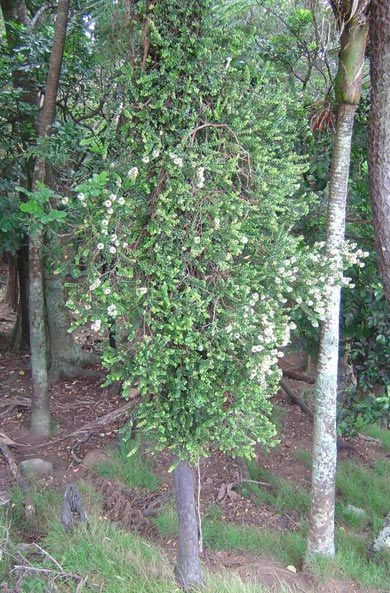
Akatea (Metrosideros perforata)
Photo: (c) Wayne Bennett, NZPCN
| 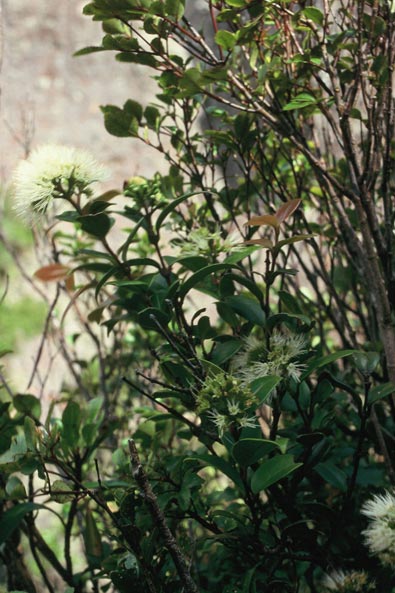
Akatea (Metrosideros albiflora)
Photo (c) Gillian Crowcroft (NZPCN) |
|
|
COGNATE WORDS IN SOME OTHER POLYNESIAN LANGUAGES
Tongan: aka "root"; aka "kudzu vine" (Pueraria lobata, Fabaceae)
Niuean: aka "kudzu bean " (Pueraria thurnbergiana, Fabaceae)
Samoan: a'a "root"; a'a "kudzu vine" (Pueraria lobata, Fabaceae)
Tahitian, Marquesan, Rarotongan: aka "root";
Hawaiian: a'a "small root";
Tuamotuan: aka "small root".
|
|
RELATED MĀORI PLANT NAMES
There is some information about the two species of rātā that are frequently referred to simply as "aka" (although each has alternative names) in the next section of this page. In this section we will list all the others we have encountered which incorporate aka (1) as a root, or (b) as a vine. The former may reflect a distant memory of the kudzo, and thus be derived ultimately from Proto Remote Oceanic *Raka, but more likely the inclusion of this element is a direct reference to its other, Proto Austronesian, origin. Where these plants have other heritage names, links will be included to the pages devoted to those names, as they are prepared. Brief notes on the others are included on this page.
"Aka" as vine or climber:
Akakiore, Akakaikiore [Rat (food) vine] (Parsonsia heterophylla, "New Zealand Jasmine", Apocynaceae). The fragrant blossoms of this vine, which flowers in Spring and Summer, have earned it the English name of "New Zealand Jasmine". There is obviously another story hidden in its Māori name. The leaves, stems and flowers of this were used as a remedy for constipation (Murdoch Riley, Herbal, p. 448)
Akakaikū, akakaikūkū, akakūkū [Pigeon (food) vine] An alternative name for Kōhia, Passiflora tetrandra, Passifloraceae, and also a generic name for Clematis spp., Ranunculaceae.
Akakopukererū [Pigeon crop vine] (Another generic name for Clematis spp., Ranunculaceae).
Akangākaukiore [Rat's vitals vine] (Clematis cunninghamii, Ranunculaceae).
Akakaimanu [Bird food vine] (Passiflora tetrandra, Passifloraceae).
Akakōhia [Kōhia vine] (Passiflora tetrandra, Passifloraceae).
Akakura [Red vine] (The carmine and red-fl owered rātā vines, Metrosideros carminea, and M. fulgens, Myrtaceae).
Akatororaro [Vine reaching out from below] (Passiflora tetrandra, Passifloraceae).
Akapōhue [Pōhue vine] (Calystegia sepium, Convolvulaceae).
Akapuka, akakōpuka [< *Puka] (Griselinia lucida, Griseliniaceae) a tree that often starts life as an epiphyte.
Aka pirita [Pirita vine] (Ripogonum scandens, "Kareao, Pirita [< *Pilita PPn], Supplejack", Smilacaceae).
Akatātarāmoa [Chicken-spur vine] (Rubus spp., "Tātarāmoa [< *Tala-a-moa], Bush lawyer", Rosaceae).
Akakura [Scarlet rātā vine] (Metrosideros fulgens, M. carminea, Myrtaceae).
Akatawhiwhi [beckoning or twirling vine, or vine like a tawhiwhi, the NZ Jasmine, Parsonsia heterophylla, Apocynaceae -- see Akakiore, above] (Metrosideros fulgens, Myrtaceae).
Akatea [White-flowered rātā vine] (Metrosideros albiflora, M perforata (see next section), Myrtaceae).
Akatoki [Axe vine] (Metrosideros perforata, Myrtaceae); the wiry stem of this climbing plant was used for lashing axes and adzes.
Akatorotoro [Vine which creeps and twines] (Metrosideros perforata , Myrtaceae); this small-leaved white-flowered rata vine and its larger leaved counterpart, M. albiflora, are als known simply as aka. See profiles below.
"Aka" as root:
Akakiekie: roots of the kiekie (Freycinetia banksii, Pandanaceae).
Akakōareare, piaka: edible roots of the raupō (Typha orientalis, Typhaceae).
Aka-o-tūwhenua [Root of the Homeland]: rhizome of the bracken fern, rau aruhe (Pteridium esculentum, Dennstaedtiaceae), once eaten as a staple food.
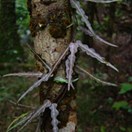
Akakaikiore
Parsonsia heterophylla |
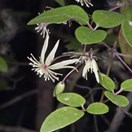
Akangākaukiore
Clematis cunninghamii |
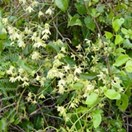
Akakopukererū
Clematis foetida |
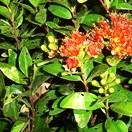
Akakura
Metrosideros fulgens |
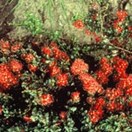
Akatawhiwhi
Metrosideros carminea |
|
|
|
AKA AS A POLYSEMANTIC GENERIC TERM AND A SPECIFIC NAME
This section discusses the use of the word aka to refer to vines, in general terms and in relation to two species which have this term unqualified as one of their names. Other plants with aka incoporated in their names are listed in the preceding section, with links to further information about those with alternative names brought from tropical Polynesia. The discussion of aka as a vine is followed by a brief examination of the word primarily referring to a root.
Looking first at aka as a vine, there are two NZ native plants which may be referred to simply as aka: the white ratas, Metrosideros perforata and M. albiflora. Note first that although "rata", from Māori rātā, is the generic name for all Metrosideros species except the pōhutukawa (M. excelsa) in New Zealand English, its use in Māori is much more restricted, and does not include these two aka.
Metrosideros perforata (aka, akatea, akatoki, akatorotoro, koro, whakapiopio) climbs to about 20 metres, clinging closely to the trunk of the host tree. It is found throughout Aotearoa. Although it shares its most widely-used Māori and English names with Metrosideros albiflora, they are very different species, albeit within the same botanical genus. The flowers of both species are white, but those of M. perforata, appearing in mid-summer to earlier autumn (from January to March) are much smaller and less abundantly produced than those of M. albiflora. The alternative name akatoki refers to the use of the stems for binding axe handles. The leaves are scattered with perforation-like oil glands, hence the specific name perforata. The main stems on mature plants may be 15 centimetres or more in diameter.
Metrosideros albiflora (aka, akatea) is distributed naturally in the Northern North Island, mostly Northland and the Coromandel peninsula in association with the kauri forest, but extending to Pukemoremore (just north of Gordonton) in the west and the Northern Kaimai range in the east. It starts flowering earlier than its English and Māori namesake M. perforata. It also climbs or scrambles to about 20 metres, branched sparingly when young, but prolifically when mature. The main stems may be 2 or 3 centimetres in diameter.
In reference to vines the term aka is found in several important traditional narratives, with mystical connotations which are reflected in chants and poetry. Elsdon Best (Forest Lore, p.73) refers to a story of the separation of the harakeke and the kiekie, the leaves of which have similar qualities and purposes. During a cosmic upheaval, the kiekie fled to Tāne (god of the forest) while harakeke followed its ancestor Wainui (personification of water, and an ally of Tangaroa, god of the Sea) to grow near and even in water. Along with other aka, kiekie now clings to trees, and has become one of the binders of Tangaroa, as the roots or stems of many aka are used to make fish traps.
The Tangi mō Te Pere (Ngā Mōteatea No. 287), for example contains what is probably a fragment of an ancient karakia incorporating this word:
Ka rangona ki reira te kupu a Te Tawhiti,
'Kei te kune. kei te weu, kei te aka,
Kei te tāmore, kei te kātoa ....'
'Twas then the voice of Te Tawhiti was heard,
Saying, 'Viable is the rootlet and the vines,
Firmly rooted is the tree. ..."
(He tangi mō Te Pere, NM 287, lines 33-35.)
The Māori name of the New Zealand Law Commission is Te Aka Matua o te Ture, 'The Principal Vine of the Law". This reflects the myth of the ascent by Tāwhaki (or Tāne in some versions) to the heavens by means of an aka - vine - to bring terrestrial, celestial and esoteric knowledge to earth, which is well-summarized by this paragraph on the Law Commission's web site:
At the foot of the ascent [Tāwhaki] and his brother, Karihi, find their grandmother, Whaitiri, who guards the vines that form the pathway into the sky. Karihi tries to climb the vines first, but makes the error of climbing up the aka taepa, or hanging vine. He is blown violently around by the winds of heaven, and falls to his death. Following Whaitiri's advice Tāwhaki climbs the aka matua, or parent vine and reaches the heavens and receives the three baskets of knowledge.
The same myth is reflected in the Oriori (lullaby) for Tu-tere-moana (NM 201), first in what the commentator on the poem, H, Te Whatahoro, notes is an injunction "to encourage the child to take hold of the teachings of the sacred house of learning" (note to Line 46):
Haramai e tama, puritia ki te aka matua
Kia whitirere ake ko te kauwae-runga, ko te kauwae raro ....
Come O Son, hold fast to the parental vine,
and awaken the celestial knowledge and the terrestrial knowledge.
and again, in line 89:
Ka toro te akaaka rangi, ka toro te akaaka whenua.
Stretched forth was the vine of the heavens, likewise of the earth.
The akatea (probably in this case Metrosideros perforata) is explicitly mentioned in another mōteatea:
Ko te whare tēnā i heke mai ai te pōkai akatea.
'Tis the house wherein the exalted seers meet.
(He Oriori nā Te Ao-Tarewa, NM 270, line 37.)
In his commentary, Pei Te Hurinui explains that 'te pōkai akatea' (literally "the
assembly of the white rata") is an oblique reference to a well-known
whakatauākī (M&G #1472):
Ko Rangitihi ūpoko whakahirahira, ko te ūpoko i takaia ki te akatea.
Rangitihi of the proud head, whose head was bound with the akatea.
Rangitihi was the father of the progenitors of the eight tribes making up the Arawa confederation, Ngā Pūmanawa e Waru o Te Arawa (The Eight Beating Hearts of Te Arawa).
His head was split open in battle, but he called for some of the akatea that bound the pallisades, which was used to bind up his wounds, after which, according to one account, he rallied his troops and turned defeat into victory.
Aka also makes a single entrance in biblical translations. In this case aka is used as the equivalent of English "bowstring", in the account of Delilah's attempts to get Samson to tell her the secret of his strength (Kaiwhakariterite/Judges, Chapter 16, v. 7-9):
... Ki te herea ahau
e ratou ki nga aka hou e whitu, kahore nei e i whakamaroketia, katahi ahau ka kahakore, ka rite ki tetahi atu tangata. Na ka maua e nga rangatira o nga Pirihitini etahi aka hou e whitu ... a herea ana ia e ia ki aua mea. ... Na motumotuhia ana e ia nga aka, koia ano kei te miro muka e motu ana ina pa ki te ahi.
... If I were bound with seven new bowstrings that had not been dried, I should lose my strength and become like any other man. The chiefs of the Philistines brought Delilah seven new bowstrings ... and she took them and bound him with them. ... But he snapped the bowstrings as a strand of tow snaps at the touch of the fire.
Note also the use of muka (flax fibre) to denote "tow". Elsewhere the transliteration waina seems to be used to refer to vines generically, probably because biblical references to "vines" generally imply grape vines.
Aka features as a root
in a not-necessarily complementary reference to someone in a "competitive action song":
Ā he waha taro a te māra i te taro o Tawhi-rangi
Te hōmaitanga o te kupenga a Tatere,
Tēnei a Pango kei Wharekaahu e takato ana,
Me he pākura kai aka raupō,
Te kō ana i roto i te otaota.
A taro-bearer from the taro plantation of Tawhi-rangi,
The harvest of the net of Tatere,
Was Pango who now lives at Wharekaahu,
Like a raupō root-eating swamp hen
Making bird noises in the undergrowth.
(He Pātere nā Titoko, NM 147, lines 39-43.)
|
| References and further reading: See linked pages and general works on NZ plants in the bibliography (which has the publication details for sources referred to in the text). Fact sheets on all the NZ native species mentioned, including Metrosideros albiflora and M. perforata, will be found on the NZPCN web site. |
Photographs: All the photographs on this page have been used with permission from members of the NZ Plant Conservation Network, and are copyright to the photographers and/or the network: Wayne Bennett (Metrosideros perforata, M. fulgens), Gillian Crowcroft (Metrosideros albiflora), John Barkla (Clematis foetida), Jeremy Rolfe (Clematis cunninghamii, Metrosideros perforata), the late John Dawson (Metrosideros carminea), Peter de Lange (Metrosideros albiflora). We are deeply indebted to these people for their support and assistance.
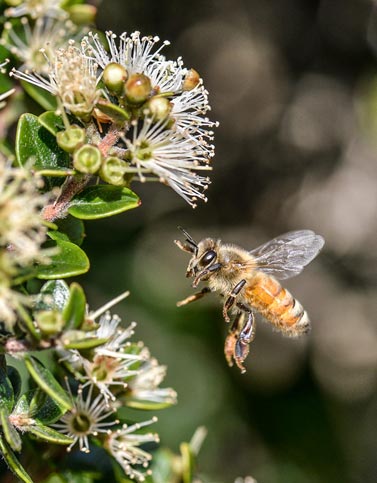
Akatea (Metrosideros perforata) and visitor
Photo: (c) Jeremy Rolfe, NZPCN
|
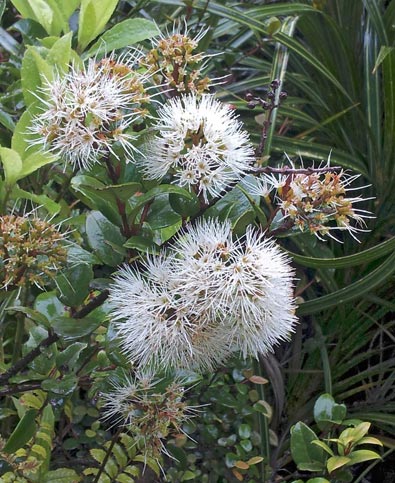
Akatea (Metrosideros albiflora) blossoms
Photo: (c) Peter de Lange, NZPCN. |
|
|
|

